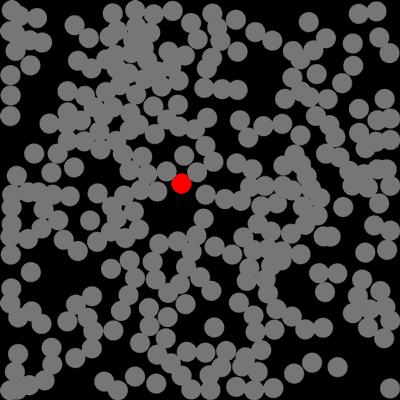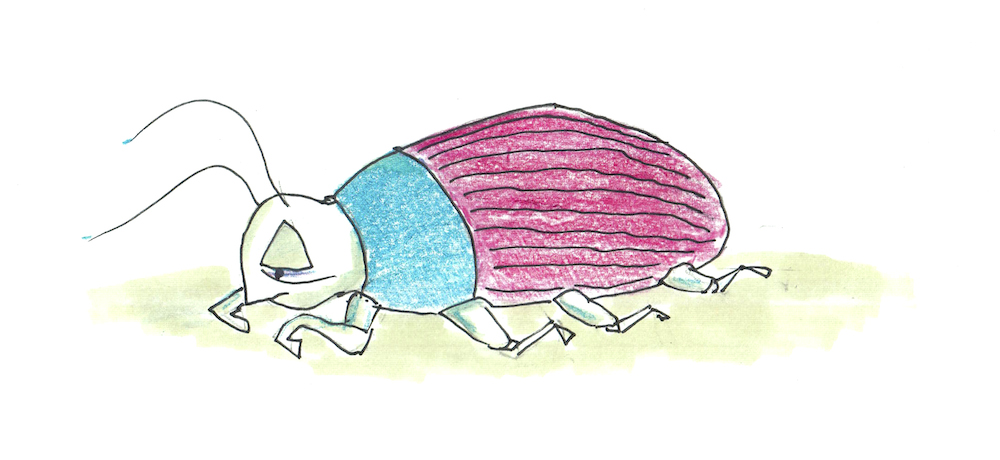We want to talk to you about breathing — something you do all the time (if you don’t, we have no idea how you’re reading this.) Breathing, of course, just happens. You don’t have to think about it much. But if you do, you’ll discover there are a vast number of animals on this planet, animals you know well, animals who buzz, bite and crawl about in plain view — who not only don’t breathe like we do, they do it so differently, we still haven’t quite figured out what they’re doing.
What we do know is the way these creatures take in air and get their oxygen is nothing short of astonishing. So that’s our topic: mysterious breathers.
We’re going to start with the familiar — with you. Take a look at this pulsing “how-we-breathe” diagram, created by the wonderful illustrator Eleanor Lutz.
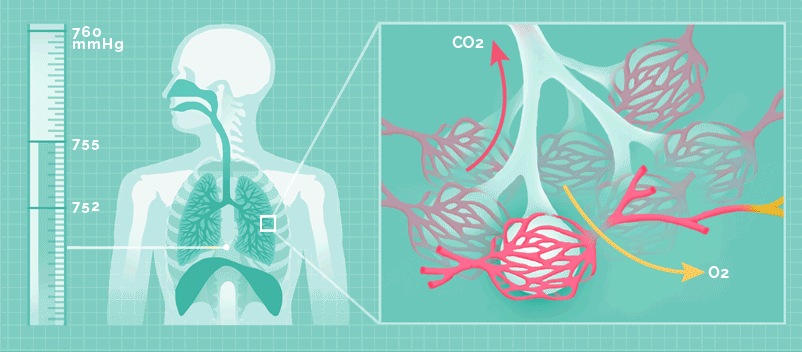
As you can see, when we humans breathe in, we lower that muscle just below our lungs — that’s our diaphragm. When it pulls down, air gets sucked in; when it pushes up, air gets squeezed out. So in effect we’ve got a pump in there, pulling oxygen into our body, sending carbon dioxide out.
But what if you’re a bird? Birds, (we didn’t know this), do it differently.
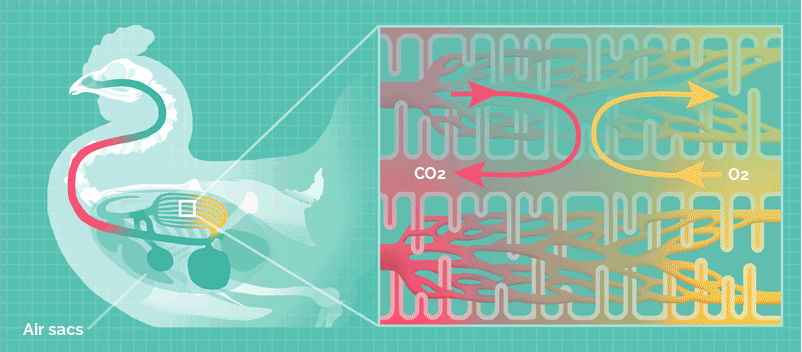
They don’t have a diaphragm, instead they pump air by inflating and deflating pouches called air sacs, and this creates the suction they need to draw air through their lungs.
But now let’s check out a grasshopper. Do you notice anything unusual?

Yes, it has air sacs to help it breathe, but notice it doesn’t use its mouth, nose, (or ears or anus) to let air in or out. It has no obvious breathing holes. How’s that possible? Where does the air come in?
Well, here’s the weird answer: A grasshopper, it turns out, breathes with its entire body. Eleanor illustrates this in her graphic by making the whole grasshopper flush yellow. And it isn’t just grasshoppers we’re talking about.
Insects (which means the majority of animals on Earth) don’t have lungs. In a sense, they are lungs. You could think of every insect as a walking, flying, hopping lung.
Here’s how it works. If you take a magnifying glass and inspect the surface of an insect, any insect, you’ll find their outsides are punctured by little holes called spiracles. Take this caterpillar, for example.
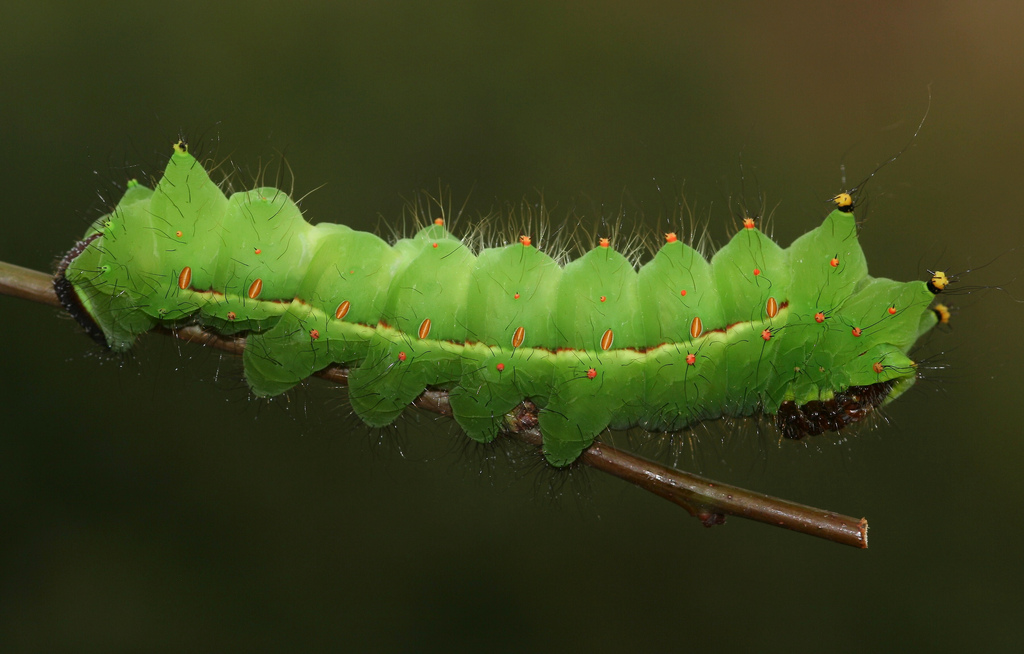
See those little orange ovals along its middle, that look a little like eyes? Let’s get up close to one of them.
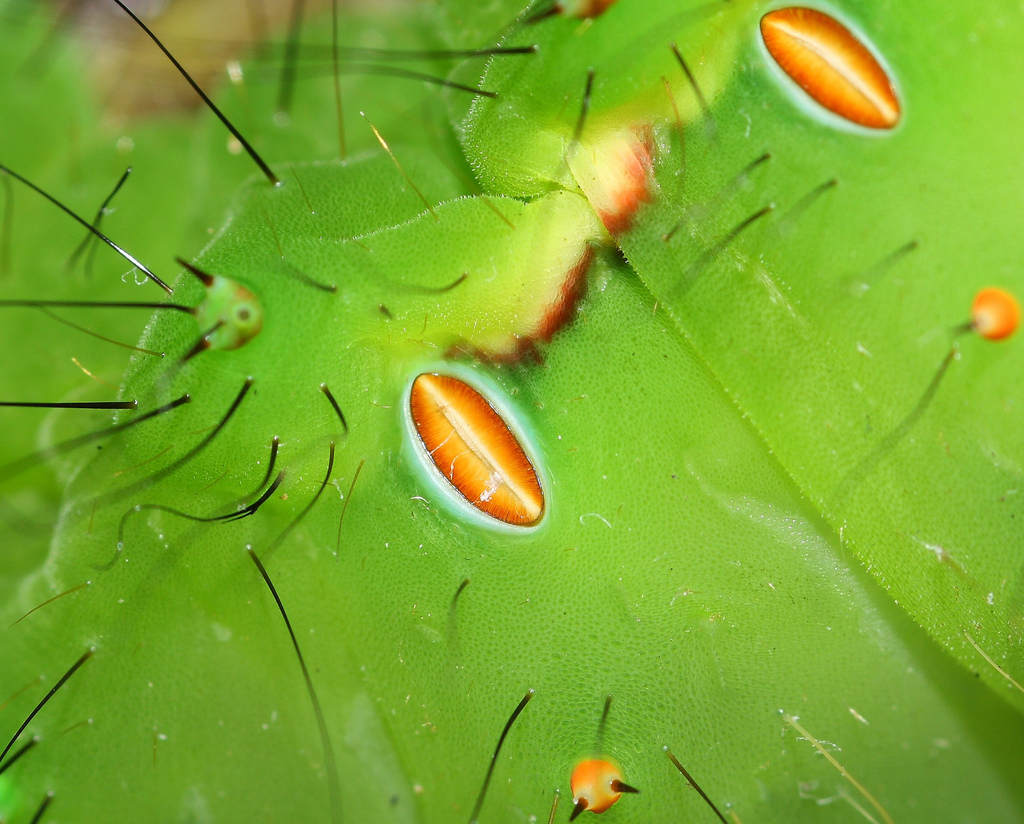
And closer still…
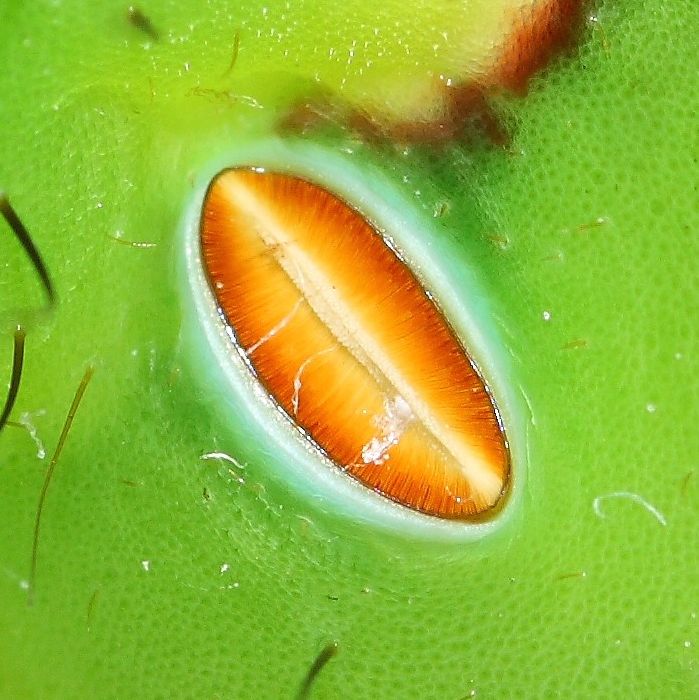
That’s actually a kind of air valve, called a spiracle. The caterpillar can open or shut it this valve, depending on whether it wants to let air in or out. If you had X-ray vision, or a dissecting knife (or if you were lucky enough to chance upon this totally see-through transparent caterpillar) you’d discover that these holes open into a maze-like network of tubes called tracheae that extend into the insect’s body.
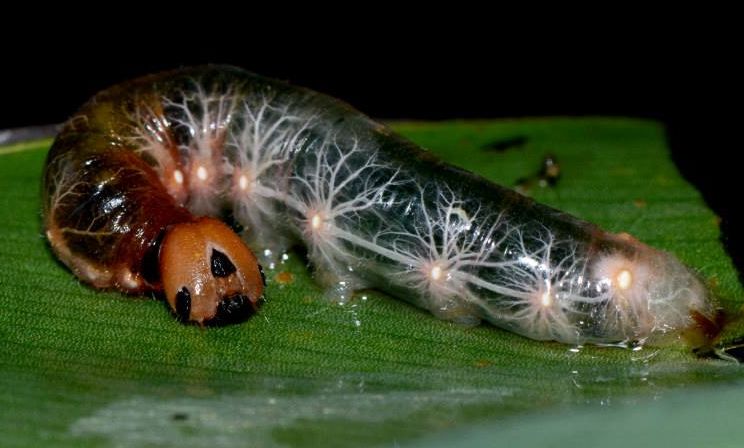
Oxygen wanders in through these spiracles (you can see the openings — that line of glowing dots that look like subway stops along the length of the caterpillar), and then drifts into a labyrinth of tubes that branch out into smaller and smaller tubes, until finally, at the teeny-tiny tips, the oxygen reaches the end of its branching journey, arriving at the insects cells.
In contrast, our bodies have a circulatory system pumping blood to get oxygen from our lungs to our cells. But in insects, there’s no blood involved in oxygen’s journey. Instead, the oxygen just floats all the way, right up to the cells’ doorsteps.
To ventilate their insides, bigger insects must actively breathe in and out, pulsing their abdominal muscles, as you see here.

But tinier insects barely budge. They breathe in a lazier way. Instead of pulsing their body, they just open their pores and sit there, like opening windows in a living room. Then they wait for the air to just… drift in.
Wait a second! WAIT A SECOND!!!
We’re writing an essay here about breathing. Breathing feels like it should be a physical act, something your body does, not just opening a body hole and thinking “come on in.” It can’t be that passive.
What’s more, says Aatish (he’s the one of us with a PhD in physics), if you know a little about the physics of air, you have good reasons to find this drift-in style of breathing – just open your pores and let the air in – more than a little puzzling. Which is why we should have…
A Short Conversation About Oxygen
(Readers with physics PhD’s should feel free to skip to the next section.)
Aatish: OK, Robert, I want you to close your eyes.
Robert: Why?
Aatish: Just do this.
Robert: Ok. They’re closed.
Aatish: Now I want you to imagine the oxygen floating in the air around you.
Robert: Ok…
Aatish: …and tell me what you imagine.
Robert: Well…
Robert: I see a molecule. Two little O’s linked together, and they’re whizzing around, like from from the window to my neck, and then… I don’t know… they bounce off my neck and ricochet from me to… to you, to your ear.
Aatish: Ah.
Robert: Ah, what?
Aatish: So you’re picturing oxygen molecules whizzing through space, bouncing off walls, and every so often they might collide with not just my ear, but with other molecules in the air.
Robert: Yeah, that’s what I was thinking…
Aatish: Well, no.
Robert: No?
Aatish: The reality is totally different. If we magnified the air around you right now, what you’d find is…
…an immensely crowded space. The air is so jampacked with molecules, our poor oxygen molecule can barely budge. Whenever it tries to move, it hits a neighbor, bounces randomly back or forward or up or down, then hits another neighbor. Can you guess how many collisions an oxygen molecule makes in a second? Just one second?
Robert: I have no idea.
Aatish: Are your eyes still closed?
Robert: Yes.
Aatish: 6 Billion.
Robert: Whaaaat?
Aatish: Yes! More than six billion bing-bangs with the neighbors. That’s so many collisions, a free-floating oxygen molecule barely gets anywhere. I read that an oxygen molecule can travel only 80 nanometers — that’s 8 millionths of a centimeter (3 millionths of an inch) — before it bumps into another molecule and goes careening off in a totally random direction.
Robert: So —-?
Aatish: So air isn’t empty space. Quite the opposite. At the molecular level, it’s more like a thick smoothie. And just like you need suction to slurp down your drink, common sense says you can’t just wait for oxygen to drift in — you need to pull it in.
If that’s so, then how do these little guys breathe?
We know they do…

Ants, mosquitoes, beetles can breathe without sucking, pulling or grabbing air. But how do they breathe without pulsing their bodies?
“The question you are asking is one that greatly troubles me,” says Jon Harrison, a scientist who’s spent years researching how insects breathe and grow.
The truth is, we haven’t quite figured it out. Harrison and his colleagues are still trying to understand how much insects breathe by oxygen drift (passive breathing) and how much by pulsing their sides (like a grasshopper).
Jon thinks that all insects can breathe passively if they absolutely have to; he says most insects can go totally without oxygen for hours at a time and not die. He’s seen animals go from active to quiet to what looks like totally dead, then miraculously bounce back. (If you want to hear some stories, click on this nearly dead beetle.)
But when little insects breathe passively, he thinks he knows how they do it. Let’s take, for example, this blue blister beetle.
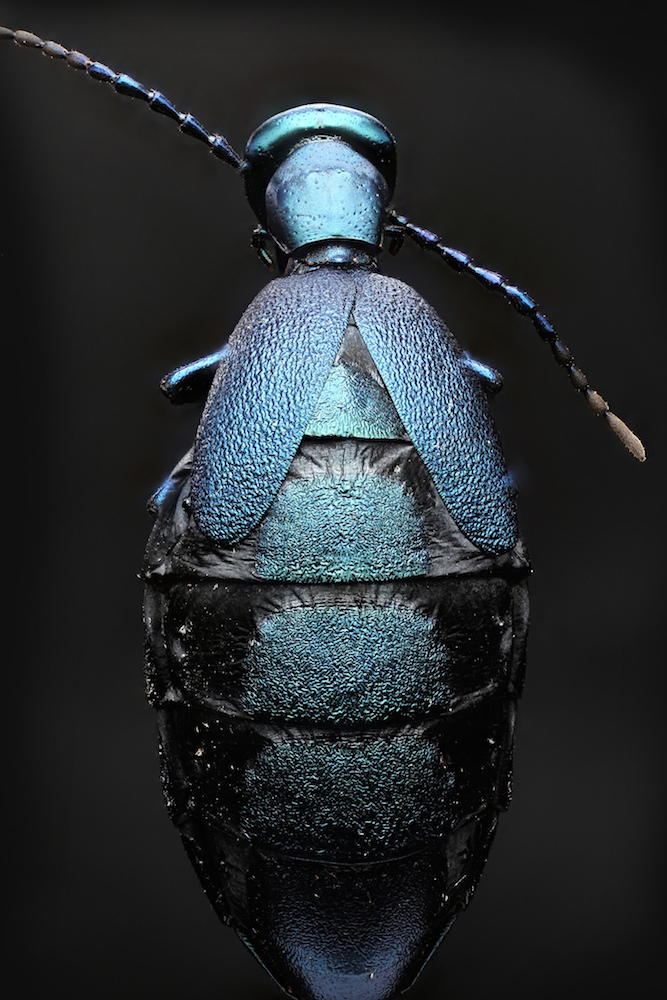
If you looked really, really closely along the beetle’s sides, you’ll find tiny holes that puncture its hard, shiny exoskeleton, just like we saw before in the caterpillar.

Those are its spiracles, the air-holes through which it breathes. Air passes through these holes to enter the beetle’s breathing tubes (its trachea).
Here’s what one of these spiracles looks like when you’re right next to it.
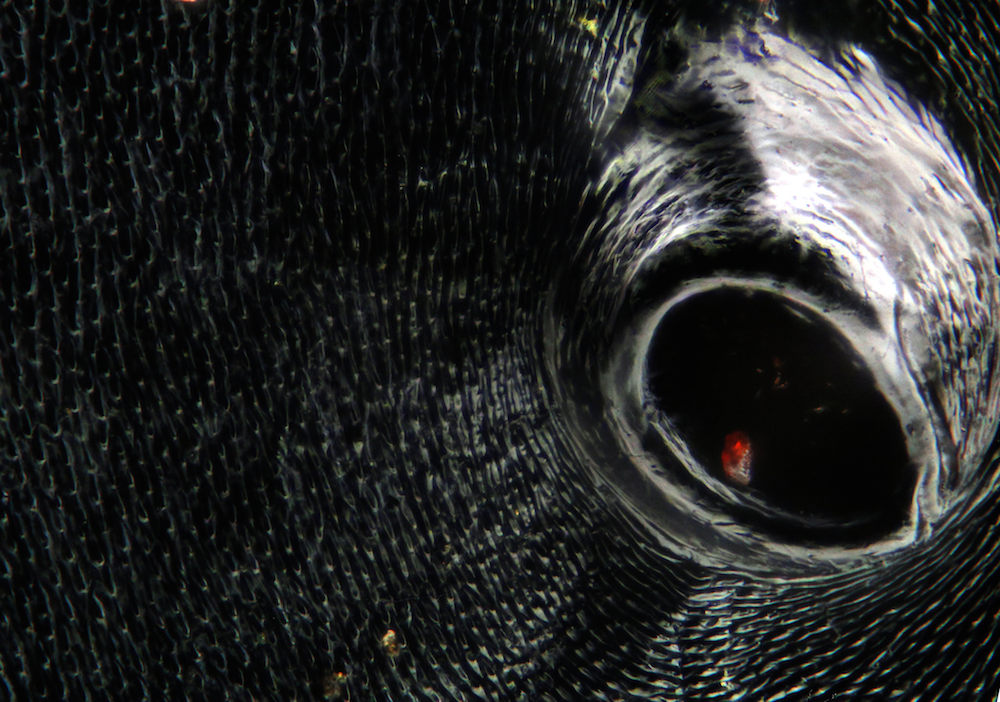
We can get in closer to see what happens on the inside. So let’s shrink down to the size of air molecules and wander inside this microscopic cavern.
Breathing is just a way to get oxygen to a hungry cell on the inside. The cell can then use this oxygen to tear apart food molecules and get the energy it needs.
So here’s our trachea. Air is coming from the left. A little ways in, we’ve placed a hungry cell looking to gobble an oxygen meal. Half an inch deeper, there’s another cell, just as hungry. The cells are waiting. We’ve painted the oxygen molecules red.
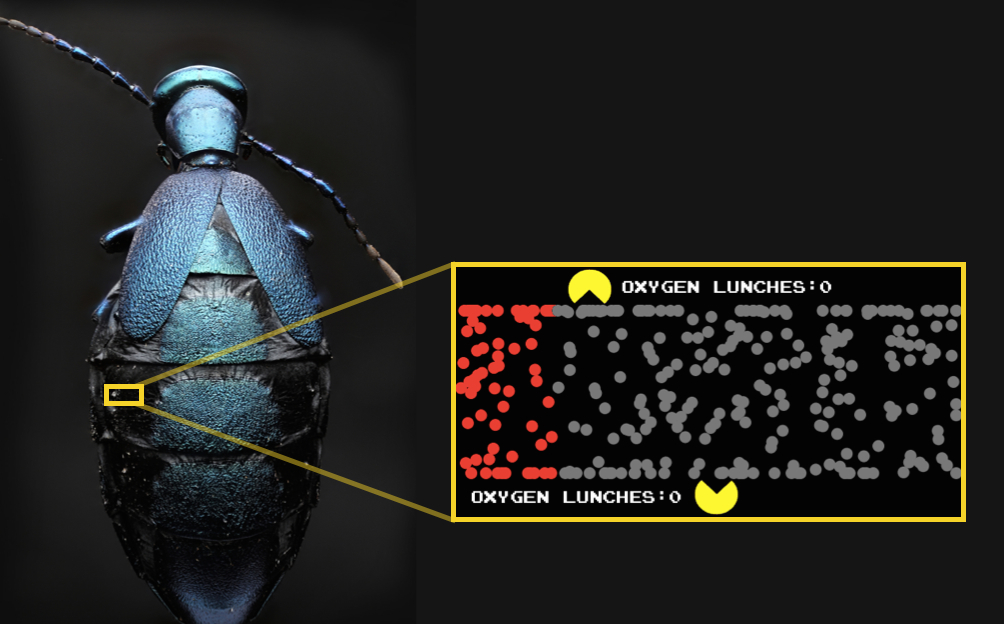
As we’ve seen already, air is a thick soup of molecules. As the fresh oxygen supply drifts into the beetle’s body, the red dots meander about randomly, each second bumping into about as many neighbors as there are people alive on Earth. So it’s no surprise, then, that they make slow progress.
If there were nothing in its way, an oxygen molecule could travel half a kilometer in a single second. But bumping through this crowd of molecules, it manages to cover just one centimeter in that time.
OK, enough talk, it’s time for lunch! Watch what happens.

Perhaps unsurprisingly, the cell closer to the surface gorges itself on oxygen. But the cell that’s deeper inside gets far fewer oxygen meals. The molecules just couldn’t reach it in time. Sad to say, the deeper cell is likely to starve. Then die.
Ah! So Breathing Affects Size
This explains something you see everywhere you look.
Animals that breathe passively with their whole bodies are always small. Think about wasps, bees, ants, houseflies, gnats, mites, centipedes, beetles. Have you ever seen a six inch housefly? Never.
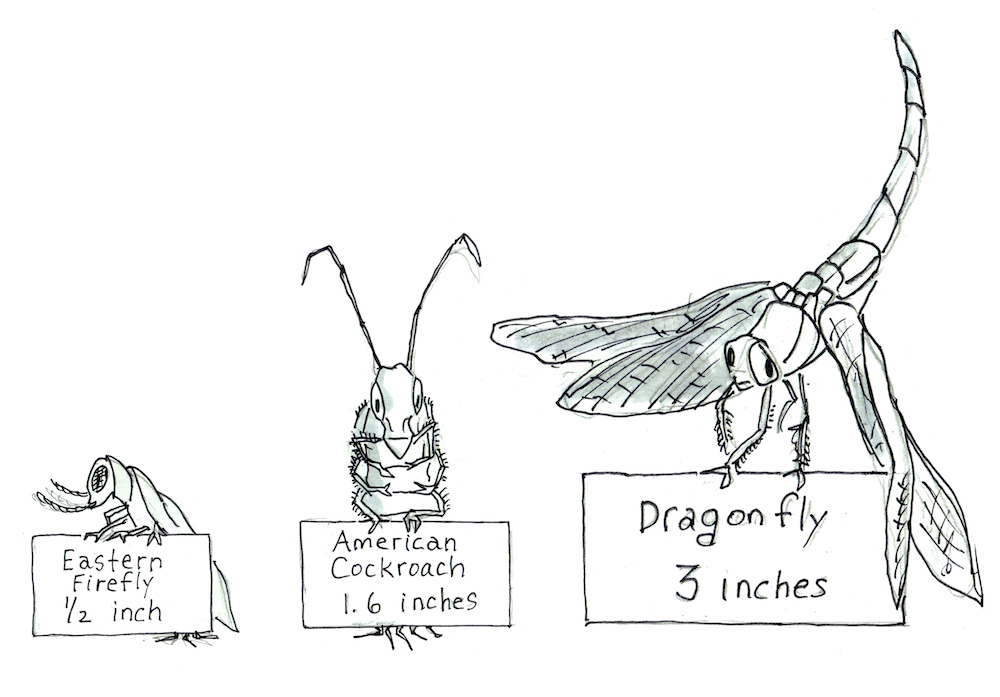
None of these guys are much larger than a few inches. Why?
Because they can’t be big. Because air molecules have such a hard time getting around, an insect’s passive breathing system can only work over a very short distance. So insects are fated to be short themselves. If they got much bigger, their insides would starve from lack of oxygen.
If humans were to breathe like insects do, with trachea instead of lungs, we’d be covered with air-holes. And because oxygen wouldn’t get very deep in us, we’d have to be much, much smaller.
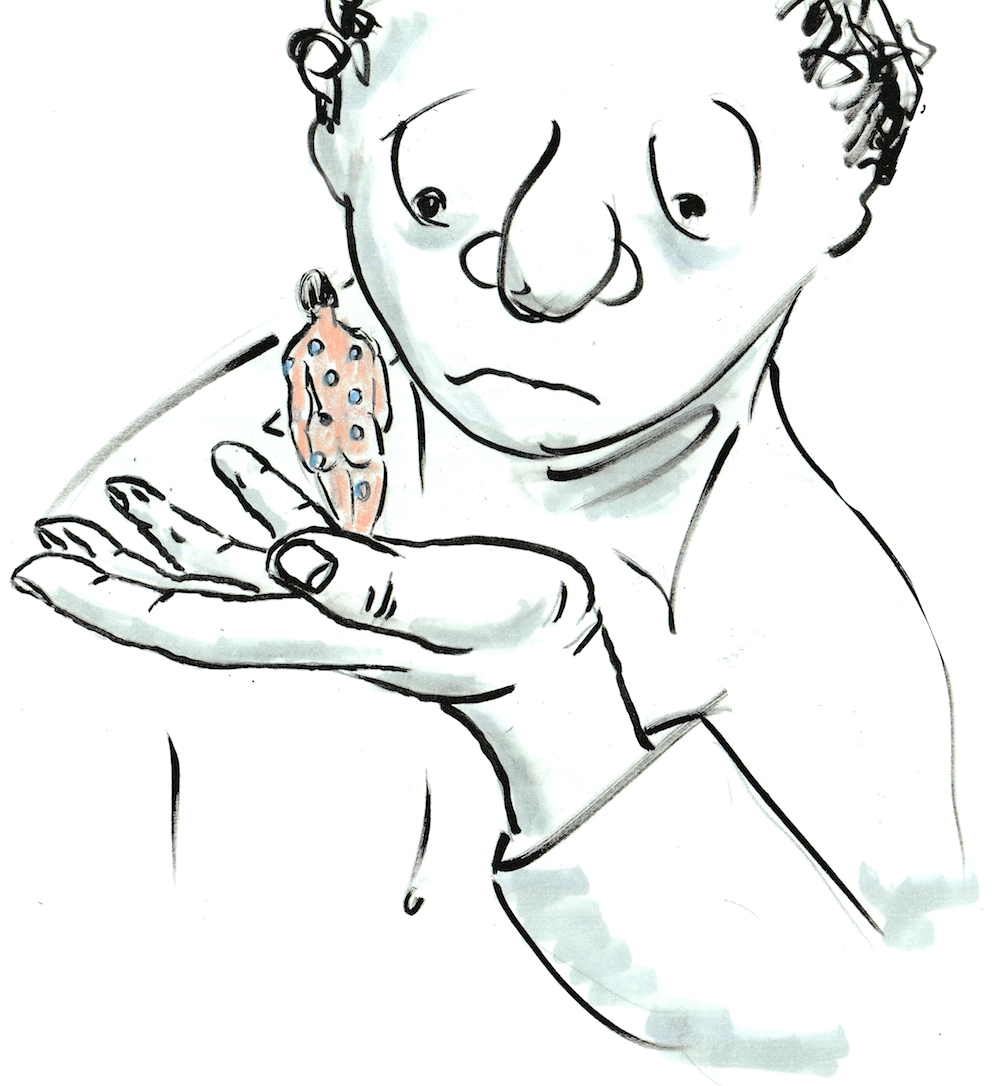
So how creatures breathe constrains their size. And this, of course, explains why you will never, ever bump into a situation like this.
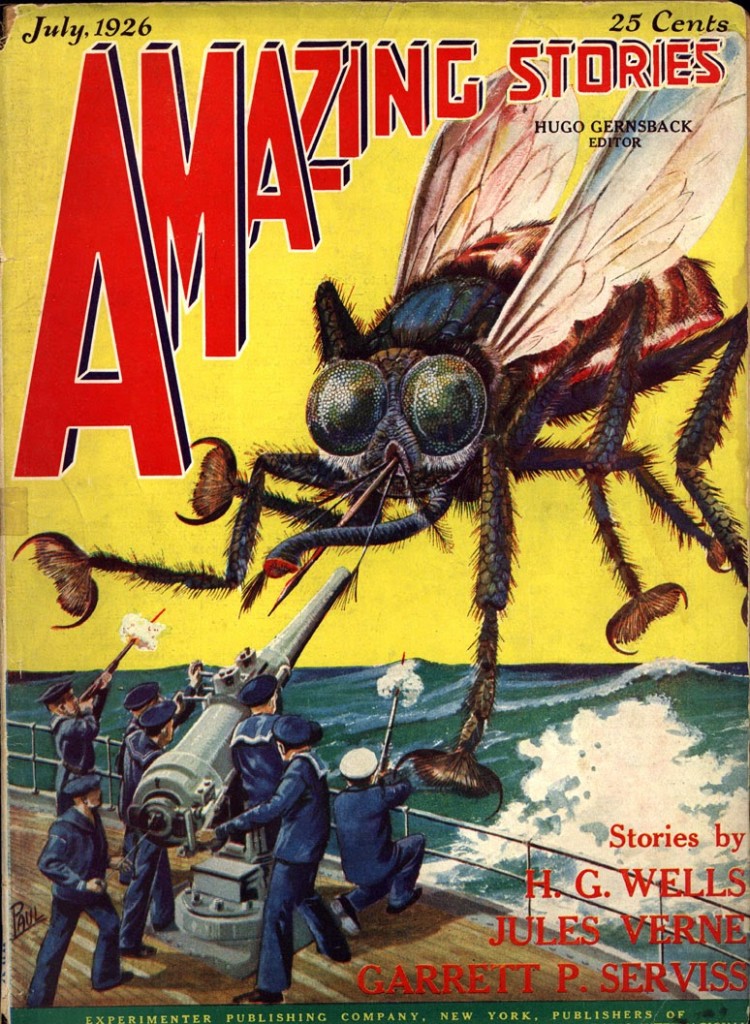
Except — and this we didn’t know — if you had been on Earth some 300 to 360 million years ago during the Carboniferous era, you would have met scarily — and we mean SCARILY large insects. Not as big as this ocean-going monster housefly, but there are fossils of Carboniferous dragonflies. They look like today’s dragonflies, with the same wings, same body shape, but back then, they measured more than two — nearly three feet across!
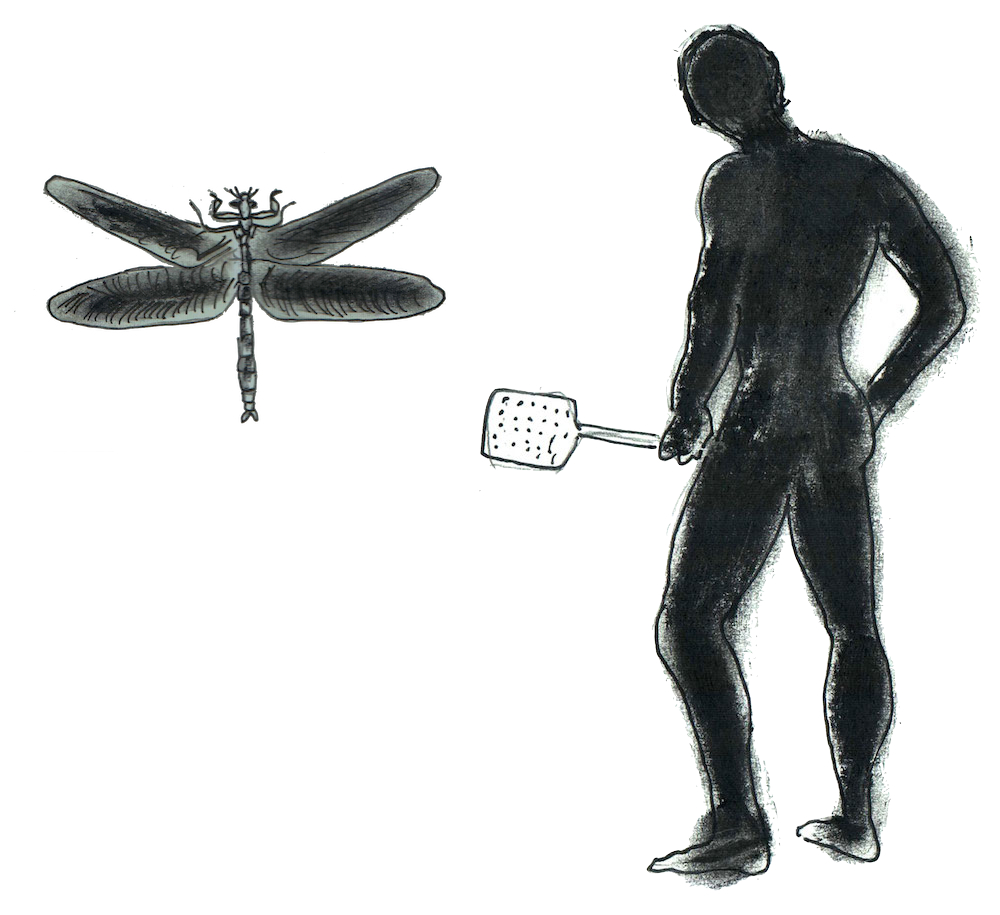
This isn’t a joke. Take a look at this fossil…
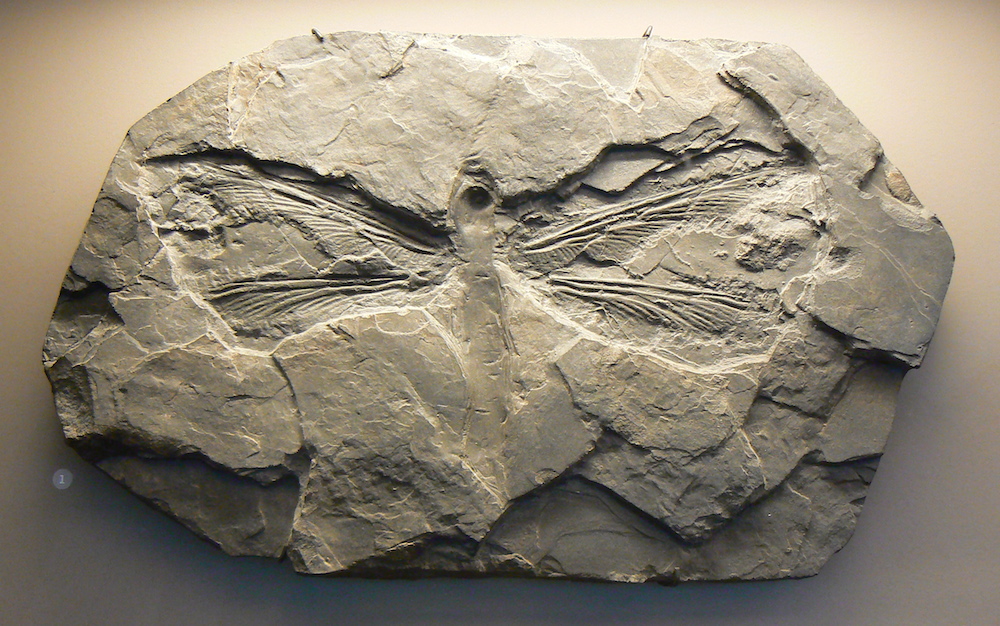
The animal in question was called Meganeura and it not only had giant wings, it had a body the size of a modern seagull. It was that big.
There were also spider-like creatures back then with leg spans (you may scream now) nearly 20 inches across; scorpions that measured over two feet — nearly a dozen times as big as scorpions you might’ve encountered — and maybe the craziest of all was a millipede, (yes, a millipede) called Arthropleura, that could grow to eight and a half feet long!
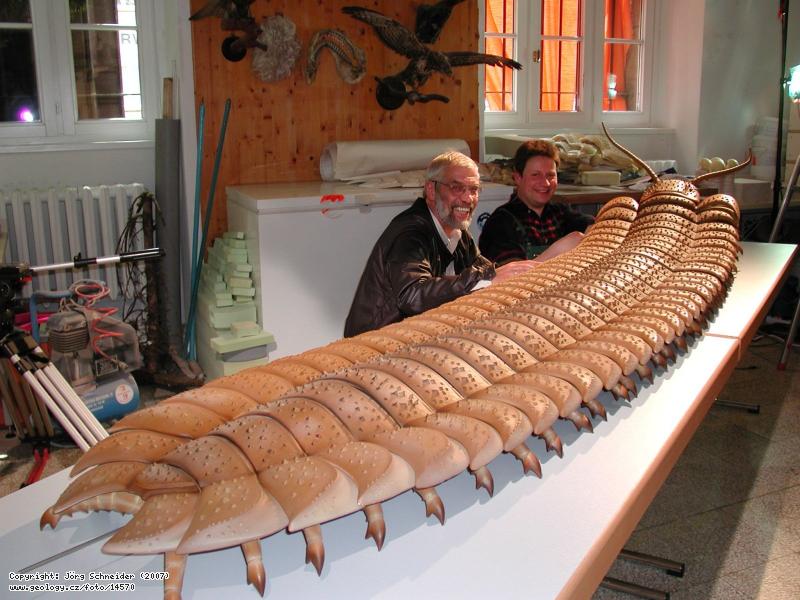
But relax, it didn’t eat meat. It liked plants.
How could these critters grow so big? It turns out the air was different back then. The world was dense with forests and swamps, so oxygen levels rose to an astonishing 35% (compared to 21% of the atmosphere today). So if you were a little spiracle on the outside of a giant millipede, there was so much more oxygen drifting down your tube. Here’s what it might look like inside you.
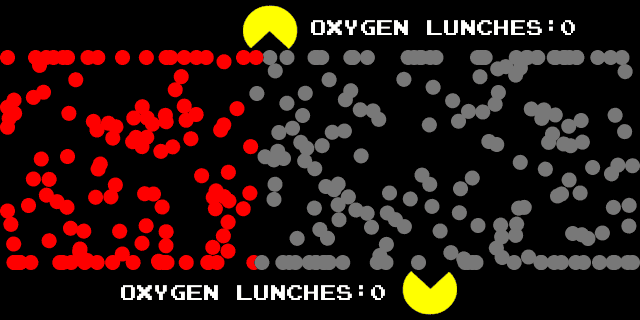
There’s now more oxygen molecules streaming in, and so, just by chance, more of them could penetrate deeper. Which means the first cell gets all the oxygen it needs, but now the second, deeper cell gets fed too! It doesn’t die. So the animal can now afford deeper insides. Which makes it bigger.
So that explains why so many animals at the same time became giants. They got more oxygen lunches.
Think about this for a second: How weird and wonderful is it that a seemingly arbitrary pattern in nature, that insects are all small, can be explained in part by imagining the crowded, frenetic, jiggling motion of invisible air molecules — that what’s in the air shapes what’s on the ground.
Who’d have guessed?
We’re going to end now. But here’s a promise. There’s one dangling chapter of this story that so delighted us we decided to turn it into a post all its own. We found a cast of tiny characters that employ some totally ingenious strategies to get their oxygen fix. There’s even one unusual insect that can breathe through its butt (we won’t show you the details yet)…

…and wait till you find out what else this animal can do with its remarkable rectum / amazing anus / bewildering butt-hole. The mind, (or rather, the body) boggles.
That’s coming next. So come back.


